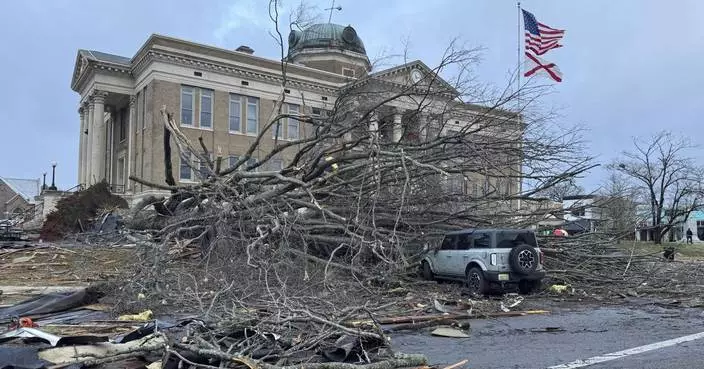BRISTOL, Conn. (AP) — The New York Mets' 4-2 comeback victory over the Milwaukee Brewers on Thursday night in the deciding game of the NL Wild Card Series averaged 4,017,000 viewers on ESPN and streaming, making it ESPN's most-watched Major League Baseball game in three years.
ESPN and Nielsen reported Friday that the audience peaked at 5.75 million viewers during the ninth inning, when the Mets rallied from a 2-0 deficit to reach the divisional round for the first time since 2015, when they reached the World Series.
It was the biggest audience for a playoff game on ESPN since the 2021 AL wild-card game, when the Boston Red Sox's win over the New York Yankees averaged 7.7 million.
This year's nine MLB Wild Card Series games averaged 2.82 million on ESPN, ESPN2 and ABC, a 25% increase over last year and a 1% gain from 2022.
AP MLB: https://apnews.com/hub/mlb

Mets' victory over Brewers in NL Wild Card Series decider was ESPN's most-watched game in 3 years

New York Mets' Pete Alonso reacts after hitting a three-run home run during the ninth inning of Game 3 of a National League wild card baseball game against the Milwaukee Brewers Thursday, Oct. 3, 2024, in Milwaukee. (AP Photo/Morry Gash)

Mets' victory over Brewers in NL Wild Card Series decider was ESPN's most-watched game in 3 years
DUBAI (AP) — England batter Joe Root and India pacer Jasprit Bumrah are among the four players in contention for the International Cricket Council's men's player of the year award.
Prolific England batter Harry Brook and Australia's Travis Head are the other two men's nominees announced by the ICC on Monday.
Bumrah has been superb with his seam bowling this year and produced another near unplayable spell when he took 5-57 in the fourth test against Australia, which finished Monday with a dramatic victory for the Australians.
It was his 13th five-wicket haul in tests and the 31-year-old now has 203 test wickets at an average of 19.42. He took 71 wickets in 13 tests this year, averaging a remarkably low 14.92. He also captured 15 wickets as India won their second men’s T20 World Cup title.
Root has enjoyed a brilliant year with the bat, scoring 1,556 runs from 17 tests with an average of 55.57.
It was the fifth time he has scored 1,000 test runs in a calendar year and his six hundreds — including a career-best score of 262 — took him to 36 test tons and joint fifth place all-time with India's Rahul Dravid.
He also surpassed Alastair Cook to become England's leading run-scorer with 12,972.
Brook compiled 1,100 runs from 12 tests at a strike rate of 85.00, showcasing both his brutal hitting and ability to improvise under pressure with some exquisite timing.
He hit four hundreds, including a superb triple century with a blistering 317 off 322 deliveries against Pakistan on an admittedly pancake-flat track in Multan — where Root made his 262 during their marathon 453-run stand.
Head, meanwhile, has stood out with his aggressive counter-attacking batting in both tests and T20s.
South Africa batter Laura Wolvaardt and Sri Lanka’s all-formats captain Chamari Athapaththu are the women’s nominees along with allrounders Annabel Sutherland (Australia) and Melie Kerr (New Zealand).
Wolvaardt scored 697 runs across 12 ODIs, averaging 87.12 with a highest score of 184 not out. She complied 223 runs across three tests, averaging 37.16 with a best knock of 122.
AP cricket: https://apnews.com/hub/cricket

FILE - New Zealand's Amelia Kerr reacts as she leaves the field after losing her wicket during the ICC Women's T20 World Cup 2024 final match between New Zealand and South Africa at Dubai, United Arab Emirates, Sunday, Oct. 20, 2024. (AP Photo/Altaf Qadri, File)

FILE - Australia's Annabel Sutherland celebrate the wicket of New Zealand's Isabella Gaze during the ICC Women's T20 World Cup 2024 match between Australia and New Zealand at Sharjah Stadium, United Arab Emirates, Tuesday, Oct. 8, 2024. (AP Photo/Altaf Qadri, File)

Australia's Travis Head plays a shot during play on the day four of the fourth cricket test between Australia and India at the Melbourne Cricket Ground, Melbourne, Australia, Sunday, Dec. 29, 2024. (AP Photo/Asanka Brendon Ratnayake)

FILE - Sri Lanka's captain Chamari Athapaththu celebrates after she runout India's Smriti Mandhana during the ICC Women's T20 World Cup 2024 match between India and Sri Lanka at Dubai International Stadium, United Arab Emirates, Wednesday, Oct. 9, 2024. (AP Photo/Altaf Qadri, File)

FILE - South Africa's Laura Wolvaardt plays a shot during the women's cricket T20 preliminary round match between New Zealand and South Africa at the Commonwealth Games in Birmingham, England, Saturday, July 30, 2022. (AP Photo/Aijaz Rahi, File)

India's Jasprit Bumrah celebrates the wicket of Australia's Travis Head during play on the day four of the fourth cricket test between Australia and India at the Melbourne Cricket Ground, Melbourne, Australia, Sunday, Dec. 29, 2024. (AP Photo/Asanka Brendon Ratnayake)


















